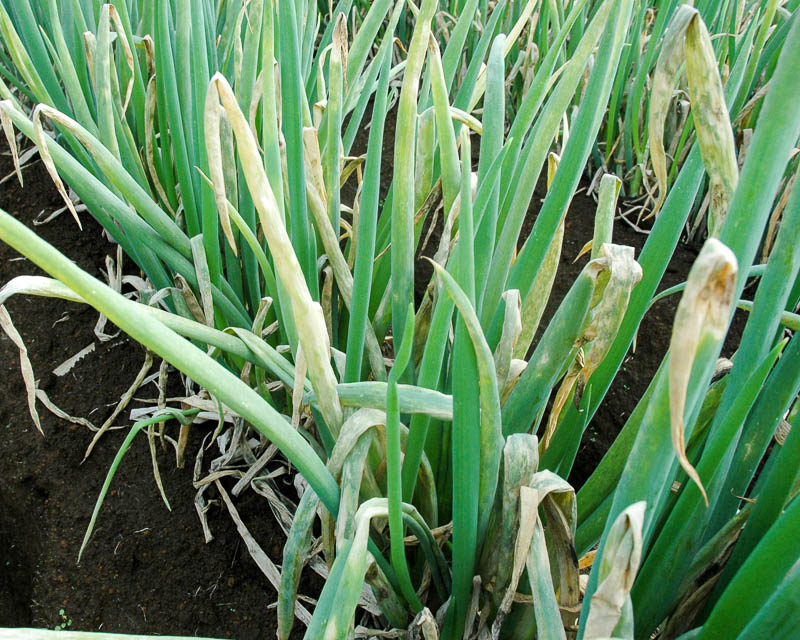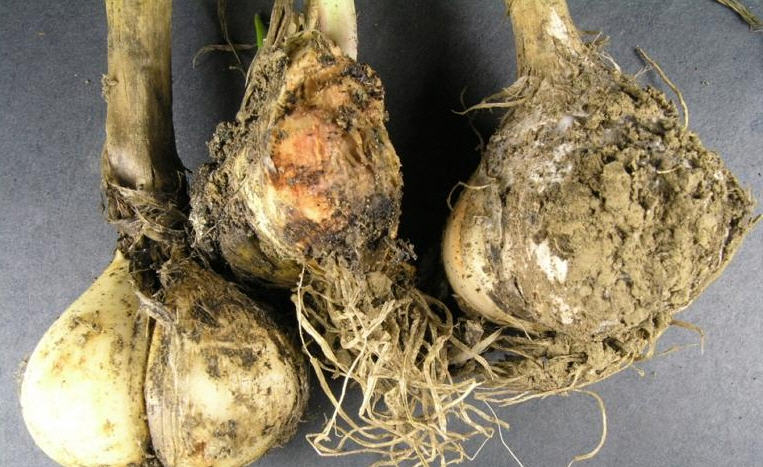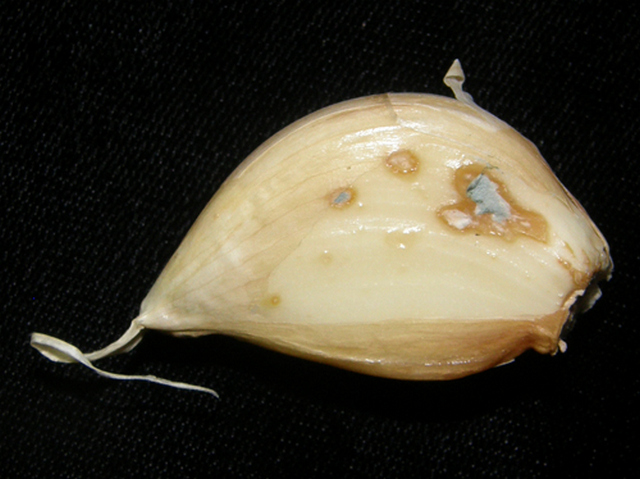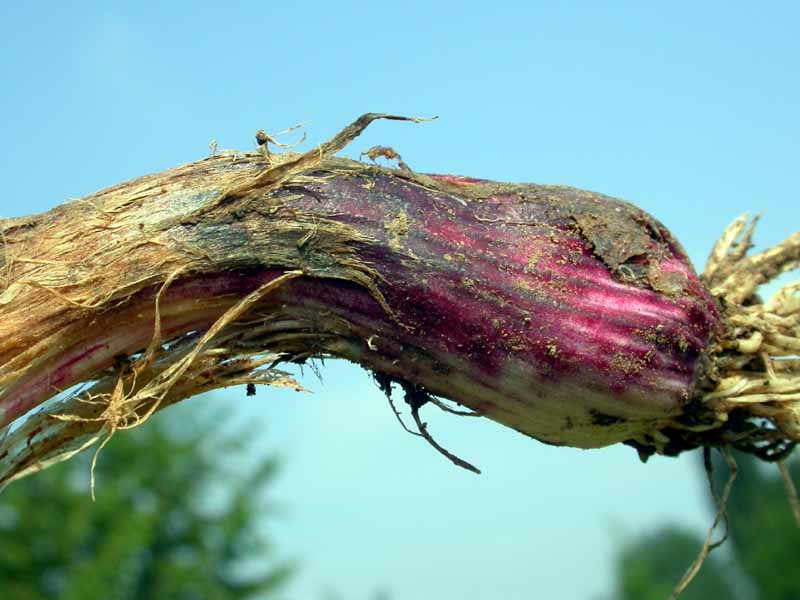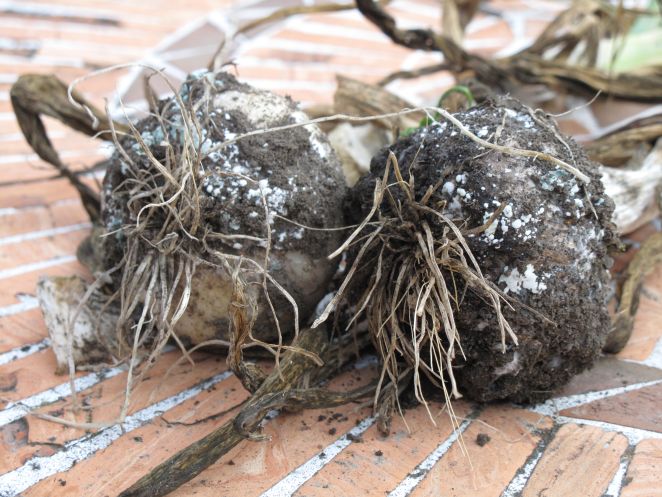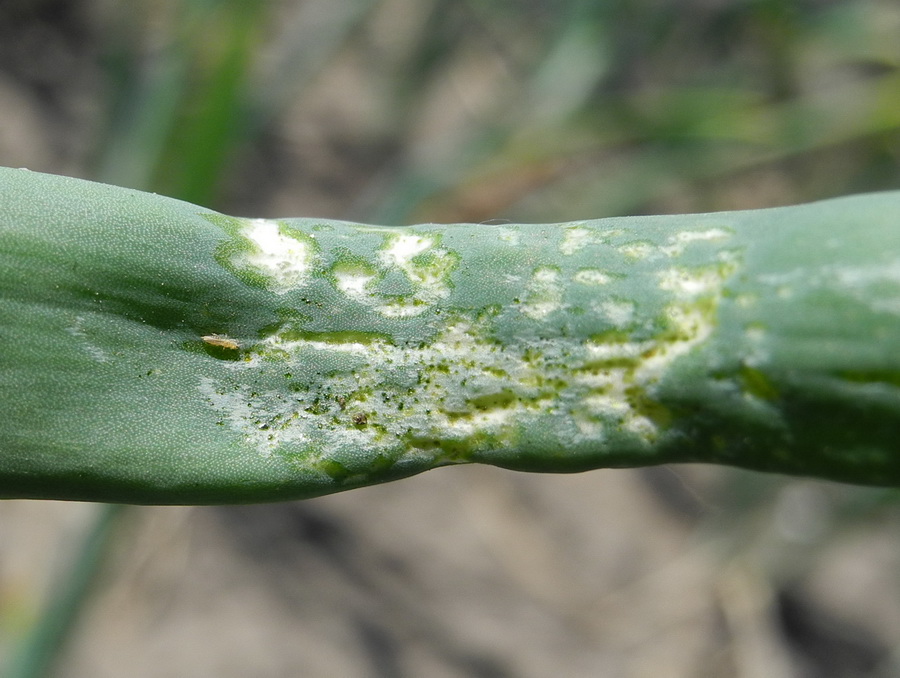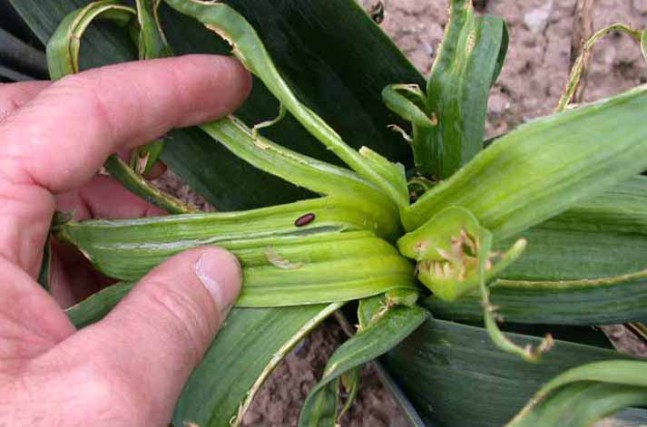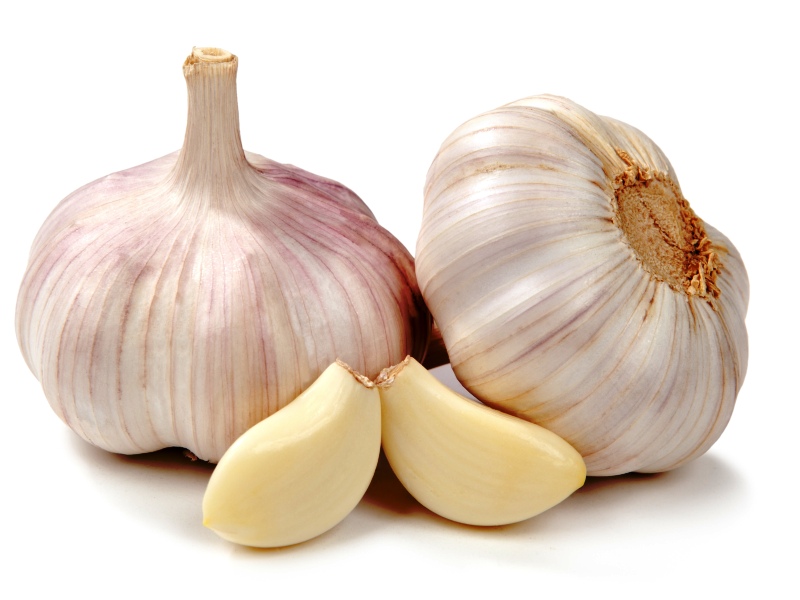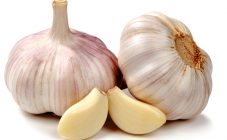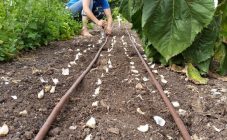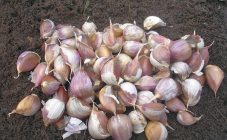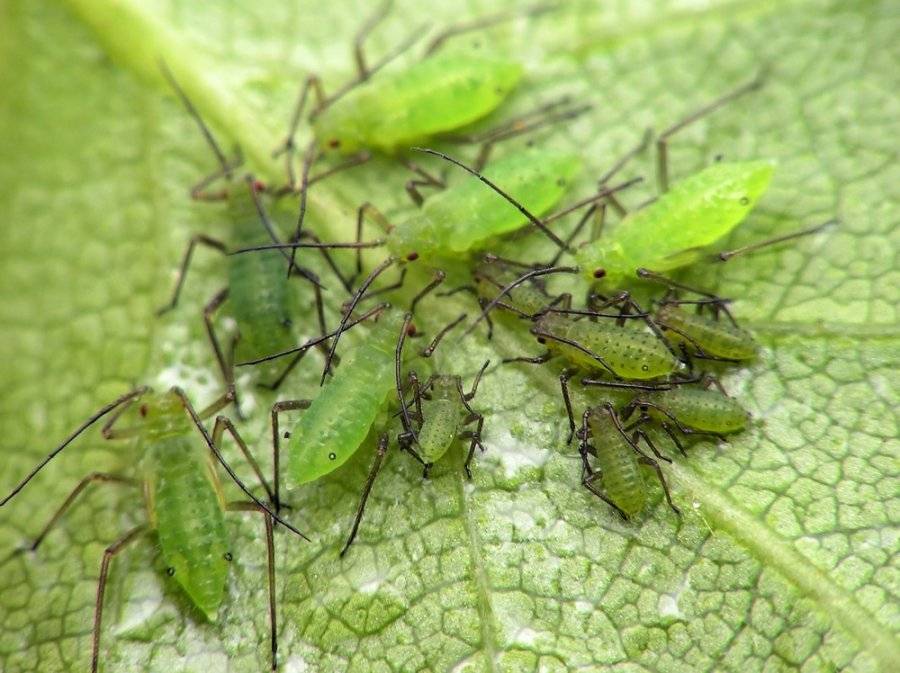Content:
In every vegetable garden there are necessarily plantings of garlic, even in small quantities. It is difficult to imagine many of the most delicious dishes without it, and its beneficial properties, which the human body cannot do without, have been known for a very long time. It can also be used to prepare infusions and decoctions to protect garden plants from diseases and harmful insects. However, garlic itself is subject to a number of diseases, like many garden crops. This article will talk about how to detect the disease in time, how to cure this beneficial culture and how to prevent the appearance of parasites on garlic.
List of diseases and treatment
Diseases of garlic are mostly bacterial or fungal. Most of the crop can die in neglected cases; if found, it is necessary to urgently fight the disease.
Peronosporosis
Peronosporosis is one of the most famous and common pathologies.
Its symptoms are as follows:
- The upper part of the stem turns yellow;
- At the same time, the stem gradually dries up;
- Plant growth slows down significantly.
This fungus can easily spread to all crops, so prevention is very important to avoid this disease.
The described pathology does not develop in bright light, as well as at high temperatures, therefore, the recommended prevention is as follows:
- Before sowing the chives, they are warmed up in the bright sun for about 2 days; it is very important that the air temperature is as high as possible;
- Also, before sowing, they well clean the soil from any organic residues and disinfect it;
- When the crop has already been harvested, you need to warm it up in exactly the same way.
The causes of this disease are the use of already infected material for sowing, poor-quality soil cleaning from organic residues and spores of fungi that can be carried by the wind. Before sowing, the drug Tiram is used, in which the cloves are soaked for 20-30 minutes.
Bacteriosis
Another serious disease of garlic is called bacteriosis. He can also outlive nearly the entire crop. Pathology tends to develop during the growing season of the plant and during the subsequent storage of the crop.
Garlic cloves do not sprout, but rot. Yellow-brown lesions appear. In other cases, the teeth become transparent, and then mucus appears on them.
To prevent the risk of damage to garlic with this disease, the following actions are used:
- Garlic is not planted in one place more than once every 4 years;
- The soil is fertilized with phosphorus before planting;
- Remove organic residues before sowing;
- The tops are removed only when it dries up at an air temperature of 20-30 degrees.
Penicellosis
During storage, garlic is affected by fungal diseases such as penicellosis or green mold. The main method of infection is the transmission of the fungus from diseased fruits to unaffected ones. The source of the disease is not the soil, since the fungus quickly dies in it without a carrier, but the affected material for planting.
The symptoms of the disease are as follows:
- Impressed, moist spots on the fruit;
- Lethargy and softened bulbs;
- A white bloom appears on the fruits, eventually acquiring a green tint;
- The bulbs are empty inside due to penetration of the spores of the fungus through tissue tears.
The disease is detectable approximately 2 months after the harvest is sent for storage. It increases with high humidity in the room and high temperatures.
It is possible to detect the fungus even during cultivation, if it is clear that:
- Feathers are subject to rapid wilting, and yellowness has formed on them;
- Plants do not reach the desired height;
- A coating appeared at the base, white or greenish.
Fusarium
In southern climates, garlic disease, fusarium, may appear. It infects the plant at high humidity during the growing season. The cause of its occurrence may lie in the water used for irrigation, with the spores of this pathology, or in the remains of last year's, infected crop.
When sowing garlic, the planting material should be clean, undamaged to avoid contamination.
To determine the presence of a pathology, you need to know what symptoms determine it:
- Yellowed stems;
- On the stems are brown stripes;
- Pink bloom in the leaf axils;
- Softened heads;
- Root rot.
Protection of garlic is achieved by the prevention of fusarium, which consists in treatment with drugs such as Fitosporin Maxim, and the beds are also watered with fungicides.
Rust
One of the types of diseases of garlic is rust, which is dangerous for crops of garlic, even winter crops. These are yellow stripes on the sheet that expand over time to such an extent that they cover the entire sheet plate. Sometimes rust may not be in the form of stripes, but represent yellow spots of a round shape, with a further transition to shades of red and acquire the shape of a bulge.
If this disease has affected garlic plants, you can see most of the loss of the crop due to the gradual loss of leaves by the crop and a decrease in the supply of nutrients necessary for the proper nutrition of the plant. The heads stop growing. How to treat garlic rust? It can be avoided, or at least the risk of developing the disease can be reduced by some preventive measures:
- 40% formalin solution, which can be prepared by mixing it 40 g with 120 liters of water, pour garlic cloves for 2 hours;
- The soil in the beds is watered with a solution of phytosporin for garlic (15 ml and 10 liters of water);
- After that, the culture is sown.
When the already planted garlic is struck by rust, they are treated with copper sulfate, and a good result is also achieved by using the Hom fungicide, together with tar soap, in a finely grated state. This composition is used to irrigate the stems every two weeks, but the last time the garlic is processed no later than a month before harvesting.
White rot
There is also another type of fungus called white rot, which is the causative agent of sclerotinia. This disease can affect garlic during plant development and storage.
It can be recognized by such changes in garlic tops:
- The leaves dry out, before that they turn yellow, starting from the top;
- The tissues at the base of the bush are softened, mycelium is visible, similar to a white bloom;
- Gradual death of the entire plant.
When storing the crop, white rot can be recognized by the mycelium, which is located at the base, and by the sign of softening of the cloves that subsequently rot.
The fungus spends winter in the ground, it can be identified by small white dots. If this is noticed, it is better not to plant garlic in this place for several years.
Fungal diseases of garlic are best prevented if possible, but if this is not possible, they are treatable.
Penicillosis and white rot are successfully treated with special preparations for garlic fungicides.
Fusarium garlic - rot at the bottom of the head. This is a fungal disease.Control methods are soaking in a fungicide and burning plants affected by the disease.
Garlic pests: control methods
Why does garlic, which can scare off many insects, is itself often spoiled by pests that destroy green feathers and heads? There are more than a hundred species of these parasites. Let's list some of them.
Spider mite
When vegetables and fruits are planted on a personal plot, you need to be prepared for the fact that the plants, in particular the garlic considered in this article, may be negatively affected by such a pest as a spider mite. It seems that on the leaves of garlic cobwebs. What to do? In fact, it is a very small sucking animal, about 1 mm. As a result of their activity (they drink all the juice from the leaves), spots of white or yellow color are formed on the leaves, which later merge together into one large spot.
Stems, shoots and leaves are enveloped in a white, at first barely noticeable cobweb, then it spreads, and the plant appears, as if in a cocoon. The fight against spider mites involves the following procedure:
- Rinse leaves and stems with soapy water;
- Provide abundant watering. Ticks don't like moisture very much;
- After that, apply insecticides, for example, Karbofos;
- Process the soil.
Tobacco thrips
Who chews on garlic? Not only garlic, but also onions and a number of other plants damage the larvae of tobacco thrips. They are brown or yellow in color, their length is only 1 mm. Females lay eggs in leaf tissue. The born larvae suck the juices from the leaves and inflorescences.
They struggle with them by alternating planted crops, disinfecting the heads before planting in hot water and loosening the earth with the addition of ash, mustard and pepper. This is a folk method.
Onion fly
Who is eating garlic in the ground? A centimeter-long onion fly has whitish larvae. She lays eggs under garlic scales or between leaves. The plant withers and dries up. At the same time, the heads become softer, rot, spreading a not very pleasant smell.
Garlic is planted earlier, when the onion fly is not yet flying. Also, to prevent its appearance and combat it, place garlic next to carrots and onions, pour it with a solution of salt, trying not to get on the feather. You can treat the garlic with a tobacco solution with pepper.
Stem nematode
Almost the most harmful to garlic is the stem nematode, which causes the plant to dry out completely. She can live in dry land for up to 5 years, eating up whatever she has to. It looks like a filamentous worm and feeds on the sap of the feather and the whole plant.
Its features are:
- Light stripes on the leaves;
- Then the leaves curl and dry;
- Pungent smell from garlic from the ground;
- The bottom of the bulb dries up and falls off.
List of spray preparations
Processing garlic in spring for pests and diseases:
- Fitosporin is an antifungal drug;
- Copper sulfate - a disinfectant;
- Herbicides are a group of weed control products. It includes drugs such as Lontrel Grand, Stomp, Targa Super;
- Fungicides - divided into organic and inorganic (pesticides). The latter are designed to destroy infection, for example, Galigan, Gezagard and Goal. Among the first, the drug Maxim is distinguished;
- Immunocytophyte is a biostimulating agent.
In general, garlic is easy to grow. If you try a little, knowing how to process garlic, you can provide yourself with a vitamin product for the whole winter. Now, if a person has the necessary information on the diseases of this plant, knowledge of control methods, garlic will certainly give a big harvest and give health to all family members.
